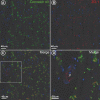Zonula occludens-1 and connexin 43 expression in the failing human heart
- PMID: 17760848
- PMCID: PMC3823265
- DOI: 10.1111/j.1582-4934.2007.00063.x
Zonula occludens-1 and connexin 43 expression in the failing human heart
Abstract
Focal disorganization of gap junctional distribution and down-regulation of the major gap junctional protein connexin 43 are typical features of myocardial remodelling in the failing human heart. Increasing evidence indicates that connexin 43 interacts with zonula-occludens-1 (ZO-1), and it has recently been shown that ZO-1 promotes the formation and growth of gap junctional plaques. In the present study, distribution patterns of ZO-1 and connexin 43 were studied in normal and in heart failure patients using double-label immunohistochemistry and confocal microscopy. ZO-1 was found to be co-localized with connexin 43 at intercalated disks. Importantly, in patients with heart failure due to dilated or ischaemic cardiomyopathy, areas of diminished connexin 43 expression were characterized by a markedly reduced ZO-1 staining. Based on these data it is concluded that in patients with heart failure, down-regulation of ZO-1 matches the diminished expression levels of connexin 43, suggesting that ZO-1 plays an important role in gap junction formation and gap junction plaque stability.
Figures


Similar articles
-
Gap junction remodelling in human heart failure is associated with increased interaction of connexin43 with ZO-1.Cardiovasc Res. 2008 Mar 1;77(4):757-65. doi: 10.1093/cvr/cvm083. Epub 2007 Dec 4. Cardiovasc Res. 2008. PMID: 18056766 Free PMC article.
-
Diminished zonula occludens-1 expression in the failing human heart.Cardiovasc Pathol. 2007 May-Jun;16(3):159-64. doi: 10.1016/j.carpath.2007.01.004. Epub 2007 Mar 21. Cardiovasc Pathol. 2007. PMID: 17502245
-
Direct association of the gap junction protein connexin-43 with ZO-1 in cardiac myocytes.J Biol Chem. 1998 May 22;273(21):12725-31. doi: 10.1074/jbc.273.21.12725. J Biol Chem. 1998. PMID: 9582296
-
Influence of the scaffolding protein Zonula Occludens (ZOs) on membrane channels.Biochim Biophys Acta. 2014 Feb;1838(2):595-604. doi: 10.1016/j.bbamem.2013.07.006. Epub 2013 Jul 15. Biochim Biophys Acta. 2014. PMID: 23867773 Review.
-
The connexin43 carboxyl terminus and cardiac gap junction organization.Biochim Biophys Acta. 2012 Aug;1818(8):1831-43. doi: 10.1016/j.bbamem.2011.08.006. Epub 2011 Aug 9. Biochim Biophys Acta. 2012. PMID: 21856279 Free PMC article. Review.
Cited by
-
Visualization of Annular Gap Junction Vesicle Processing: The Interplay Between Annular Gap Junctions and Mitochondria.Int J Mol Sci. 2018 Dec 22;20(1):44. doi: 10.3390/ijms20010044. Int J Mol Sci. 2018. PMID: 30583492 Free PMC article.
-
The paradigm of postconditioning to protect the heart.J Cell Mol Med. 2008 Apr;12(2):435-58. doi: 10.1111/j.1582-4934.2007.00210.x. Epub 2007 Dec 20. J Cell Mol Med. 2008. PMID: 18182064 Free PMC article. Review.
-
Adenovirus targets transcriptional and posttranslational mechanisms to limit gap junction function.FASEB J. 2020 Jul;34(7):9694-9712. doi: 10.1096/fj.202000667R. Epub 2020 Jun 2. FASEB J. 2020. PMID: 32485054 Free PMC article.
-
Cardiac fibroblasts inhibit β-adrenoceptor-dependent connexin43 expression in neonatal rat cardiomyocytes.Naunyn Schmiedebergs Arch Pharmacol. 2013 May;386(5):421-33. doi: 10.1007/s00210-013-0843-6. Epub 2013 Mar 3. Naunyn Schmiedebergs Arch Pharmacol. 2013. PMID: 23455518
-
Oxidant stress derails the cardiac connexon connection.J Clin Invest. 2010 Jan;120(1):87-9. doi: 10.1172/JCI41780. Epub 2009 Dec 28. J Clin Invest. 2010. PMID: 20038808 Free PMC article.
References
-
- Dupont E, Matsushita T, Kaba RA, Vozzi C, Coppen SR, Khan N, Kaprelian R, Yacoub MH, Severs NJ. Altered connexin expression in human congestive heart failure. J Mol Cell Cardiol. 2001;33:359–71. - PubMed
-
- Kostin S, Rieger M, Dammer S, Hein S, Richter M, Klövekorn WP, Bauer EP, Schaper J. Gap junction remodeling and altered connexin 43 expression in the failing human heart. Mol Cell Biochem. 2003;242:135–44. - PubMed
-
- Kostin S, Dammer S, Hein S, Klövekorn WP, Bauer EP, Schaper J. Connexin 43 expression and distribution in compensated and decompensated cardiac hypertrophy in patients with aortic stenosis. Cardiovasc Res. 2004;62:426–36. - PubMed
-
- Saffitz JE, Schuessler RB, Yamada KA. Mechanisms of remodeling of gap junction distributions and the development of anatomic substrates of arrhythmias. Cardiovasc Res. 1999;42:309–17. - PubMed
Publication types
MeSH terms
Substances
LinkOut - more resources
Full Text Sources
Other Literature Sources
Medical
Miscellaneous

